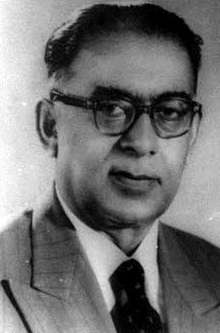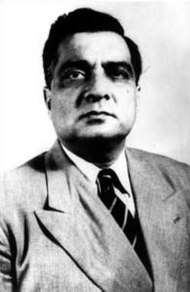1958 Pakistani coup d'état
The 1958 Pakistani coup d'état refers to the events between October 7, when the President of Pakistan Iskander Mirza abrogated the Constitution of Pakistan and declared martial law, and October 27, when Mirza himself was deposed by Gen. Ayub Khan, the Commander-in-Chief of the Pakistani Army. There were a number of Prime Ministers between 1956 and 1958 and it reached a stage when General Ayub Khan felt the army should take control to restore stability. East Pakistan’s politicians wanted more say in the running of the central government which increased tension. Iskander Mirza had lost the support of many of the leading politicians and was alarmed at a plan by Suhrawardy to unite the political leadership of Bengal and Punjab against him. Therefore he turned to Ayub Khan and the military for help.
| Pakistani coup d'état in 1958 | |||
|---|---|---|---|
| Part of Governance crisis in Pakistan after the independence | |||
  Prime Minister Feroze Khan (1893–1970) and President Iskander Mirza (1899–1969) | |||
| Date | 7 October 1958–27 October 1958 | ||
| Location | |||
| Caused by |
| ||
| Methods | Curfew, Media blackout, mass media manipulation and propaganda against elected politicians, mass incarceration of political workers, suspension of fundamental rights such as right to assembly and expression | ||
| Status | Establishment of the Presidential republic. | ||
| Parties to the civil conflict | |||
| |||
| Lead figures | |||
| |||
History
An eminent reason of Ayub Khan declaring martial law was the canal water disputes-tensions started to rise and the agricultural based economy of Pakistan largely sacrificed. Iskander Mirza failed to deal with the Indian threat. Ayub started to dislike the democratic system. In 1956, the Constituent Assembly of Pakistan approved a constitution that ended Pakistan's status of an independent Dominion of the British Empire, to create the Islamic Republic of Pakistan. Maj. Gen. Iskander Mirza, the last Governor General of Pakistan, simultaneously became the state's first president. However, the new constitution was followed by political turmoil in Pakistan, which saw a succession of four prime ministers - Chaudhry Muhammad Ali, Huseyn Shaheed Suhrawardy, Ibrahim Ismail Chundrigar and Sir Feroz Khan Noon - in a period of two years.[1] There was already a precedent in Governor General Malik Ghulam Muhammad dismissing prime ministers and ruling by decree, and many viewed Mirza as manipulating the constitution and instigating ousters of governments.[1] The One Unit scheme amalgamating the provinces of Pakistan into two wings - West Pakistan and East Pakistan - was politically controversial and proving difficult to administer. The quick succession of prime ministers fostered the view within the military and in the public that Pakistani politicians were too weak and corrupt to govern effectively, and that the parliamentary system was flawed.
Martial law
On October 7, President Iskander Mirza declared martial law in Pakistan. He abrogated the constitution of 1956, describing it as "unworkable" and full of "dangerous compromises."[2] He dismissed the government of Sir Feroz Khan Noon, dissolved the National Assembly of Pakistan and the provincial legislatures. Mirza also proceeded to outlaw all political parties.[2] He appointed General Ayub Khan, the Commander-in-Chief of the Pakistani army as the Chief Martial Law Administrator and nominated him to become the new Prime Minister of Pakistan, charged with administering the country.[2]
Deposing of Mirza
On October 27, Iskander Mirza resigned from the presidency, transferring it to Ayub Khan.[2] Both men saw the other as a rival to their respective positions. Mirza believed his own position had become largely redundant after Ayub Khan assumed most executive powers as chief martial law administrator and prime minister, and acted to assert himself, while Ayub Khan thought Mirza was conspiring against him.[2][3] It is widely held that Ayub Khan and generals loyal to him forced Mirza to resign.[2][3] Mirza was later taken to Quetta, the capital of the province of Baluchistan, before being exiled on November 27 to London, England, where he resided until his death in 1969.[3]
Consolidation
Ayub Khan combined the offices of president and prime minister, becoming both the head of state and government. He created a cabinet of technocrats, diplomats and military officers. These included Air Marshal Asghar Khan and Zulfikar Ali Bhutto, the future prime minister. In contrast with future Pakistani military rulers such as Gen. Zia-ul-Haq and Gen. Pervez Musharraf, Ayub Khan did not seek to hold the posts of president and army chief simultaneously.[3] He appointed Gen. Muhammad Musa as the new commander-in-chief.[3] Ayub Khan also obtained judicial validation of his move when the Supreme Court of Pakistan validated and legalised his take-over under the "Doctrine of necessity."[3][4][5]
Reactions
The coup was received positively in Pakistan as a relief from unstable governments and weak political leadership.[3] There was hope that a strong central leadership could stabilise the economy and promote modernisation and the restoration of a stable form of democracy.[3] The Ayub Khan regime was also supported by foreign governments such as the United States.[3]
Further reading
- Maya Tudor, "The Promise of Power: The Origins of Democracy in India and Autocracy in Pakistan."(Cambridge University Press, 2013).
- Aqil Shah, "Army and Democracy: Military Politics in Pakistan" (Harvard University Press, 2014)
- K.B. Sayeed, "The collapse of Parliamentary Democracy in Pakistan," Middle East Journal, 13.4 (1959), 389–406
See also
References
- Nagendra Kr. Singh (2003). Encyclopaedia of Bangladesh. Anmol Publications Pvt. Ltd. pp. 9–10. ISBN 978-81-261-1390-3.
- Salahuddin Ahmed (2004). Bangladesh: past and present. APH Publishing. pp. 151–153. ISBN 978-81-7648-469-5.
- Dr. Hasan-Askari Rizvi. "Op-ed: Significance of October 27". Daily Times. Retrieved 2018-04-15.
- "Coups and courts". Frontline - The Hindu, Vol. 24, Issue 23. 2007-11-23. Retrieved 2010-09-17.
- Mazhar Aziz (2007). Military control in Pakistan: the parallel state. Psychology Press. pp. 66–69. ISBN 978-0-415-43743-1.